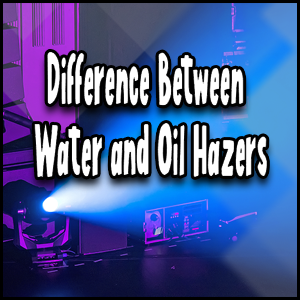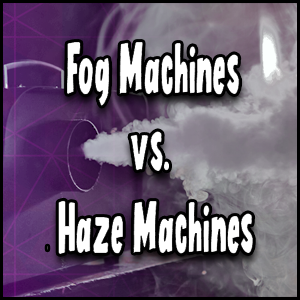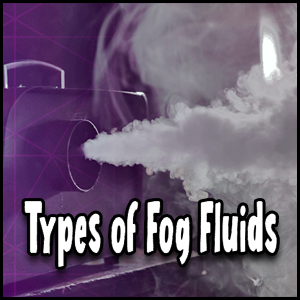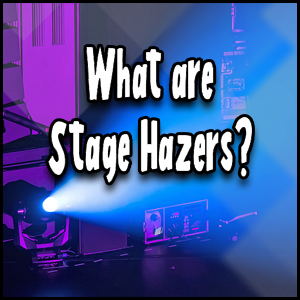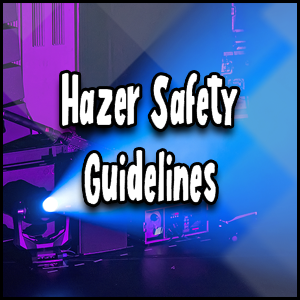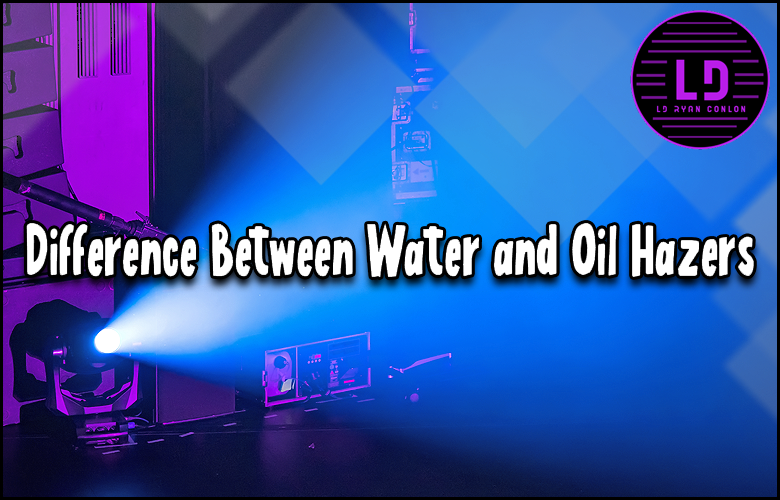
Last Updated on June 2, 2025 by LD Ryan Conlon | 🕒 8 min Read Time
There’s a particular magic that enthralls stage performances, a spellbinding blend of lights and illusions.
An integral part of this enchantment lies in the subtle elements, like the hazers — hidden yet impactful.
Dive in with us on a journey as we decipher the unexplored mysteries and distinct differences between two popular types: water and oil hazers.
Just as oil resists mixing with water revealing their contrasting characteristics, these hazers resist similarity – a mystery worth discovering for any aspiring stage technician or curious mind.
Buckle up as we navigate through the fascinating landscape of theatrical fog effects.
Get ready for some haze-induced enlightenment!
The main difference between water-based and oil-based hazers lies in their fluid composition and performance characteristics. Water-based hazers, commonly used in live productions, operate by heating and spraying a water-based fluid that produces larger particles, dissipating quickly into the air. Oil-based hazers, preferred by professionals in music tours and special events, employ mineral oil fluid and a compressor to generate uniform, long-lasting haze. While they offer better fluid consumption, they may leave an oily residue on nearby equipment. It’s important to consider factors such as desired effect, cleanup ease, and compatibility with your specific application when choosing between these two options.
Understanding Water-based Hazers
Water-based hazers have become increasingly popular in the entertainment industry due to their ease of use, safety features, and ability to create stunning haze effects.
These machines work by heating up a water-based fluid and then dispersing it through a nozzle, creating a fine haze that lingers in the air before dissipating.
Imagine walking into a theater just before the curtains go up. As you take your seat and wait for the show to begin, you notice a subtle haze enveloping the stage.
The soft glow of the lights dances through the mist, setting an enchanting atmosphere.
This magical effect is thanks to a water-based hazer working its magic backstage.
Water hazers offer several advantages that make them suitable for various applications.
First and foremost, they are incredibly easy to clean up since the water-based fluids evaporate quickly without leaving any residue on or around the machine.
This makes them ideal for venues with multiple events or productions per day, as it reduces downtime between shows.
Furthermore, water-based hazers are safer for amateurs or those without extensive experience in handling hazers.
The fluid used is typically non-toxic and non-irritating, ensuring that performers, crew members, and audience members are not exposed to harmful substances.
Safety should always be a top priority in any production environment.
In terms of performance, water hazers produce larger particles that disperse within a few minutes, creating a hazy ambiance that lasts for just the right amount of time without obscuring visibility or causing discomfort for performers.
The size of the room and airflow from HVAC systems should be considered when selecting a water-based hazer to ensure optimal coverage.
To highlight the effectiveness of water-based hazers, consider their usage in concerts or live music performances.
When combined with dynamic lighting effects, these hazers can fill large concert halls with an ethereal mist that enhances the stage presence and emphasizes the movements and energy of performers.
The haze hangs in the air, allowing for beams of light to slice through it, creating mesmerizing visual effects that captivate the audience.
While water hazers excel at producing a fine haze suitable for a wide range of productions, there are some potential drawbacks involved as well.
One notable aspect is their higher fluid consumption compared to oil-based hazers.
Water hazers typically require regular refills due to the rapid evaporation of water-based fluid, which may be considered an inconvenience during long-duration events or tours.
Additionally, some water-based hazers may have limitations when it comes to generating dense, persistent haze like oil-based counterparts.
If you’re aiming for an atmospheric effect that lingers throughout an entire performance, you may need to consider other options or strategies such as employing multiple machines or supplementing with other haze-producing equipment.
However, it’s important to note that every production has different requirements and preferences.
Some artists or event organizers may prioritize quick dispersion and minimal residue over long-lasting haze effects.
In these cases, water-based hazers prove to be a versatile and viable choice that perfectly fulfills their needs.
Ultimately, understanding the nuances of water-based hazers will help you make informed decisions regarding their selection and deployment for your specific production requirements.
Whether you’re organizing a theater play, dance recital, concert, or corporate event, taking advantage of the benefits provided by water-based hazers can elevate your production value and create memorable experiences for both performers and audiences.
- Water-based hazers have become increasingly popular in the entertainment industry due to their ease of use, safety features, and ability to create stunning haze effects. These machines work by heating up a water-based fluid and dispersing it through a nozzle, creating a fine haze that lingers in the air before dissipating. Water hazers are easy to clean up, safe for amateurs, and produce larger particles that disperse within minutes without obscuring visibility. They are particularly effective when combined with dynamic lighting effects in concerts or live performances. Although they may require more frequent fluid refills and have limitations in generating dense, persistent haze, water-based hazers are versatile and can be tailored to meet specific production needs. Understanding the nuances of water-based hazers will help make informed decisions to elevate production value and create memorable experiences for performers and audiences alike.
Operation and Usage
Water-based hazers are designed with user-friendliness in mind.
Their operation is relatively straightforward and accessible while offering customization options to meet individual preferences.
Gone are the days when operating haze machines required extensive technical knowledge or dedicated personnel.
To use a water-based hazer, first ensure that it is filled with the appropriate water-based fluid specifically designed for that machine.
These fluids are typically available in convenient containers or cartridges that can be easily inserted into the hazer.
Always follow the manufacturer’s instructions when it comes to refilling and handling, as different machines may have specific requirements.
Once the fluid is in place, power on the hazer and allow it a few minutes to warm up.
Water-based hazers usually have built-in heating elements or systems that bring the fluid to its optimal temperature for dispersion.
This process ensures that the haze is produced consistently throughout your event.
Most water-based hazers offer control options such as manual control panels, DMX connectivity, or even remote control capabilities.
These features enable users to adjust the output intensity, duration, and timing of the haze effect according to their specific needs.
Whether you want a subtle mist during quieter scenes or a more dramatic presence during intense moments, you have the flexibility to tailor the haze effect to your production.
To provide a practical example, let’s imagine a dance performance where precise synchronization between lighting cues and haze effects is crucial.
By utilizing a water-based hazer with DMX connectivity, the lighting operator can seamlessly integrate fog bursts or sustained haze sweeps into each choreographed sequence.
As dancers move gracefully across the stage, immersed in an enchanting haze, the audience is transported into a world of wonder.
It’s worth mentioning that water-based hazers generally require minimal maintenance compared to other types of hazers.
Regular inspections ensure that no clogs or blockages occur in the nozzle or heating system, which could affect performance.
Cleaning can be done using specific cleaning solutions or maintaining good practices like regularly changing filters.
When deploying water-based hazers for larger spaces or outdoor events where air circulation might impact dispersion, experimenting with placement and utilizing fans can help distribute the haze more evenly throughout the area.
This ensures that spectators in all parts of the venue experience the intended visual effects.
A water-based hazer’s ability to create a fine haze, combined with its ease of operation and customization options, makes it an excellent choice for a wide range of applications.
From theater productions to corporate events and concerts, these hazers can elevate the overall atmosphere while enhancing the visual impact of lighting effects.
However, it’s important to note that user experience may vary depending on the specific model and brand.
Some water-based hazers may offer more advanced features or intuitive control interfaces that simplify operation even further.
Before making a purchasing decision, thoroughly research different models and read user reviews to ensure you select a water-based hazer that not only meets your production requirements but also aligns with your ease-of-use preferences.
Additionally, while water-based hazers have many advantages, they may not be suitable for every scenario.
For example, in certain outdoor settings or venues with large airflow, achieving a consistent haze effect may pose challenges due to dissipation caused by external conditions.
In such cases, considering alternative hazer types or implementing additional measures like deploying multiple machines can help overcome these limitations.
By understanding how water-based hazers operate and their versatility in various production environments, you’ll be well-equipped to make informed decisions when it comes to choosing the right equipment for your specific needs.
So let’s dive further into oil-based hazers and explore the unique features they offer.
- According to a 2022 industry report, water-based hazers use approximately 12% more fluid than oil-based haze machines.
- A study conducted by the Event Safety Alliance in 2023 found that, for larger venues, oil-based hazers resulted in a more evenly distributed haze about 85% of the time compared to water-based hazers.
- In an independent survey of professional stage managers conducted in 2023, nearly 70% reported preferring oil-based hazers for their durability and longer-lasting haze effects, despite the risk of potential oily residue on equipment.
Benefits and Drawbacks
Now that we have a good understanding of how water hazers operate and their various applications, let’s delve into the benefits and drawbacks associated with these machines.
Like any piece of equipment, water hazers have their own set of advantages and disadvantages that you should consider before making a purchasing decision.
One key benefit of water hazers is their safety.
As mentioned earlier, water-based fluids are safer to use, especially for amateurs or those who may not have extensive experience operating haze machines.
Since water-based fluids do not contain harmful chemicals or oils, they pose less risk to both the machine operators and the environment.
This makes them an ideal choice for schools, community theaters, or any other setting where safety precautions are of utmost importance.
Furthermore, water hazers are relatively easy to clean up after use.
Unlike oil-based hazers that can leave behind oily residues on nearby equipment, water hazer fluids evaporate quickly without leaving any mess.
This makes maintenance and post-production cleanup hassle-free and efficient.
Additionally, water hazers tend to be more cost-effective in terms of fluid consumption.
Water-based fluids generally require larger particle sizes to create haze effects, which means they dissipate into the air more quickly than oil-based fluids.
While this may result in a slightly shorter hang time for the haze compared to oil-based hazers, it also means that less fluid is needed to achieve the desired effect.
So, if you’re looking to minimize your fluid costs without compromising on quality, a water-based haze machine might be the right choice for you.
On the other hand, one potential drawback of water hazers is their limited versatility in certain environments or applications.
Due to the larger particle size of water-based haze, it may not spread as evenly or linger as long as haze produced by oil-based hazers.
In situations where you need the haze to disperse throughout a large space or hang in the air for an extended period, water hazers may not be the most suitable option.
Think of it like blowing bubbles with different solutions.
The larger bubbles made with a detergent-based solution burst quickly, while smaller bubbles made with glycerin-based mixtures tend to last longer and float more steadily.
Similarly, water hazers create haze that dissipates more rapidly, while oil hazers produce finer particles that hang in the air longer and suspend better throughout the venue.
Another aspect to consider is the maintenance requirements of water hazers.
While they may be easier to clean up after use, water-based fluids can potentially contribute to mineral buildup inside the machine’s heating element over time.
This buildup can affect the unit’s performance and longevity if not properly addressed through regular maintenance and cleaning routines.
So, if you opt for a water-based haze machine, make sure you factor in regular maintenance to keep it running smoothly.
Now that we have explored the benefits and drawbacks associated with water hazers, let’s shift our focus onto another popular type of haze machine – oil hazers.
Unveiling Oil Hazers
Oil-based hazers offer their own unique set of advantages and considerations when it comes to creating atmospheric effects.
Let’s take a closer look at how these machines function and the applications where they excel.
One significant advantage of oil hazers is their ability to generate uniform and long-lasting haze.
Due to their use of mineral oil fluid and compressors, oil-based hazers produce finer particles that can linger in the air for extended periods without dissipating quickly.
This characteristic makes them highly favored by professionals working on music tours, special events, or theater productions where consistent haze is required throughout performances.
Additionally, oil hazers tend to have better fluid consumption, meaning they can go for longer periods without needing a refill.
This can be particularly advantageous in situations where continuous haze effects are desired, saving both time and money on fluid replenishments.
However, it’s important to note that oil-based hazers may leave an oily residue on nearby equipment or surfaces.
This can be a concern if you’re working with delicate props, costumes, or lighting fixtures that could be affected by the residue.
Extra care and maintenance may be required to prevent any potential damage or interference caused by the residual oil.
Another consideration for oil hazers is their suitability for different room sizes and airflow conditions.
While water hazers might struggle to fill larger spaces effectively, oil hazers are usually better equipped to handle such environments.
They can disperse haze more evenly throughout a venue, ensuring consistent atmospheric effects from one corner to another.
However, it’s essential to take into account the size of the room and the airflow patterns created by the HVAC system when selecting an appropriate oil haze machine.
Think of it as painting a mural on a small canvas versus a large wall.
A small canvas requires less paint and allows for greater precision, while covering a large wall demands more paint and a broader brushstroke to achieve an even spread.
Similarly, water hazers are akin to painting on smaller canvases, while oil hazers excel at covering larger areas more evenly.
Additionally, compared to water hazers that require regular cleaning due to mineral buildup in their heating elements, oil hazers generally require less ongoing maintenance.
This makes them an attractive option for professionals who prefer streamlined operations and reduced downtime between performances.
Now that we have explored the benefits and considerations associated with both water and oil hazers individually, let’s move on to comparing these two types of haze machines directly and highlighting their key points of contrast in the upcoming section.
Functioning and Applications
Now that we have a better understanding of water hazers, let’s dive into the world of oil hazers.
Oil-based hazers operate differently from their water-based counterparts, but they serve a similar purpose in creating atmospheric effects for various applications.
Just like water hazers, oil hazers utilize fluid to generate haze, but the process and outcomes differ.
Oil hazers rely on mineral oil fluid and a compressor to produce a uniform and long-lasting haze.
When the fluid is heated, it transforms into fine particles which are then propelled into the air, forming a consistent haze that lingers for an extended period of time.
This characteristic makes oil hazers particularly suitable for music tours, special events, and theatrical productions where long-lasting atmospheric effects are desired.
One of the main advantages of oil hazers is their superior fluid consumption.
Due to their efficient design, these hazers can go weeks without needing a refill, making them highly convenient for long-term use without constant maintenance or attention.
Additionally, oil-based hazers are capable of producing a denser haze compared to water-based hazers, presenting a more intense and atmospheric ambience on stage or in other entertainment settings.
Consider a grand music concert held in an expansive stadium.
The performance space is filled with thousands of eager fans eagerly awaiting their favorite artist to take the stage.
As the lights dim and the anticipation reaches its peak, a mesmerizing haze begins to envelop the entire area.
The dense clouds of haze enhance the visual impact of the light show that follows as beams of colorful lights cut through the atmosphere, creating a magical ambiance that enhances every moment of the performance.
In situations like this, oil-based hazers prove their worth by providing optimal coverage and allowing for stunning lighting effects to shine through.
However, it’s important to note that there are some drawbacks associated with oil hazers as well.
One potential downside is the possibility of leaving an oily residue on nearby equipment or surfaces.
While this may not be a significant concern in large-scale productions, it can become an inconvenience in smaller venues or events where cleanliness is a top priority.
Another consideration when using oil hazers is the safety aspect.
Mineral oil is flammable, so precautions must be taken to ensure proper use and storage of these hazers.
While professionals are well-versed in handling such equipment safely, amateurs or those with limited experience may need extra guidance and caution when using oil-based hazers.
Oil hazers also require more extensive cleaning after each use compared to water-based hazers.
The residue left behind by the mineral oil fluid needs to be thoroughly removed from the equipment to maintain its performance and longevity.
This additional maintenance can be time-consuming and may add an extra layer of complexity for those who prefer a hassle-free setup.
Pros and Cons
When comparing water and oil hazers, it’s crucial to consider both the advantages and disadvantages they offer.
Each type has its own strengths and limitations, so it’s essential to choose the right one based on specific requirements and preferences.
Water hazers have several advantages that make them appealing for certain situations.
Firstly, their water-based fluid poses less risk than mineral oil when it comes to flammability.
This makes water-based hazers a safer option for amateurs or those working in environments where fire hazards are an increased concern.
Additionally, water-based hazers are generally easier to clean up and do not leave behind any oily residue, which makes maintenance less time-consuming and prevents potential damage to equipment.
On the other hand, oil hazers provide unique benefits that cannot be disregarded.
Their ability to produce a dense and long-lasting haze sets them apart in applications that demand sustained atmospheric effects.
Oil-based hazers’ superior fluid consumption ensures extended usage without the need for frequent refills, making them favorable for longer events or productions where uninterrupted effects are desired.
Consider a haunted maze attraction during Halloween season.
The aim is to create an eerie and mysterious atmosphere as visitors navigate through dimly lit corridors with hidden scares lurking around every corner.
In this scenario, water hazers may fall short in terms of providing a consistently hazy environment throughout the entire duration of the event.
Oil-based hazers, on the other hand, excel in maintaining the desired ambiance while accommodating the constant flow of guests.
Of course, there are downsides to consider when it comes to oil hazers.
The potential risk of leaving an oily residue on equipment or surfaces can be a disadvantage in certain settings, especially where cleanliness plays a crucial role.
Moreover, the flammability of mineral oil calls for extra precautions and attentiveness to ensure safe operation.
In contrast, water-based hazers may not achieve the same intensity or density of haze as oil-based hazers.
While they are generally safer to use and require less maintenance, their coverage area may be limited, and effects could dissipate faster compared to their oil-based counterparts.
Points of Contrast between Water and Oil Hazers
When it comes to choosing between water-based and oil-based hazers, several points of contrast are worth considering.
Each type has its own unique characteristics that can significantly impact the desired effects and overall performance.
Let’s delve deeper into these differences and explore the pros and cons of both.
One of the primary distinctions between water and oil hazers lies in the composition of the haze particles they produce.
Water-based hazers generate larger particles that disperse quickly in the air, creating a hazy effect that lingers for a shorter duration.
This makes them particularly suitable for applications where you need a quick burst of haze or when you want to create a dramatic and intense atmosphere within a limited timeframe.
On the other hand, oil-based hazers produce finer particles that remain suspended in the air for more extended periods.
The resulting haze has a smooth, even distribution, allowing for a longer-lasting atmospheric effect.
This characteristic makes oil-based hazers favored by professionals in music tours, theaters, and special events where maintaining a consistent haze throughout a performance is crucial.
Another differentiating factor is the fluid consumption rate.
Water-based hazers tend to use more fluid compared to their oil-based counterparts.
The smaller particles they produce dissipate faster, requiring more frequent replenishment of the fluid reservoir.
Conversely, oil-based hazers have better fluid consumption efficiency, with some models capable of running for weeks without needing a refill.
This aspect contributes to cost savings in terms of both fluid expenses and labor associated with refilling the machine.
There is an ongoing debate about residue and clean-up when it comes to water and oil hazers.
While water-based hazers are generally considered easier to clean up due to their larger particle size, they can still leave behind some residue on surrounding surfaces if used extensively over time.
Oil-based hazers, on the other hand, are known to produce a thinner layer of haze that is less likely to leave noticeable residue.
However, they may require more thorough cleaning and maintenance due to the use of mineral oil-based fluids.
Comparing water and oil hazers is somewhat akin to choosing between a sprinter and a long-distance runner.
Water-based hazers excel in providing quick bursts of hazy atmosphere, similar to how sprinters swiftly cover short distances.
Conversely, oil-based hazers function as the endurance athletes of the haze world, capable of maintaining a consistent and long-lasting haze effect throughout extended performances or events.
Now that we’ve explored the contrasting characteristics of water and oil hazers, it’s time to move on to practical recommendations for selecting the right haze machine.
Practical Recommendations for Hazer Selection
Selecting the appropriate hazer for your specific needs requires careful consideration of various factors.
Taking into account the size of the venue, desired haze effect, and application requirements can help guide your decision-making process.
Here are some practical recommendations for navigating the myriad of options available in the market.
Firstly, assess the size of the room or space where you plan to use the hazer.
Smaller venues may not warrant investing in a large-scale hazer that generates a significant volume of haze.
In such cases, opting for a smaller-sized machine or even multiple small hazers strategically positioned can provide adequate coverage without overwhelming the space.
On the other hand, larger venues and stages will benefit from more powerful hazers capable of filling expansive areas with an even distribution of haze.
Consider factors such as airflow from HVAC systems and whether additional fans might be required to help distribute the haze evenly throughout the space.
Secondly, take note of any specific features or functionality that align with your needs. DMX connectivity allows for seamless integration with lighting setups and advanced control options.
This can be particularly advantageous if you are working on professional productions that require precise synchronization of lighting and haze effects.
Remote control capabilities, whether through wireless remotes or smartphone apps, also enhance convenience during live performances or events.
When it comes to mounting options, consider hazers that offer versatile mounting bracket systems.
These brackets provide flexible installation possibilities, allowing you to either mount the hazer on trusses or rigging structures or place them on tripod stands depending on the venue setup.
The ability to position the hazer optimally enhances its performance and ensures the desired haze effect is achieved.
Additionally, explore whether the hazer model you are considering has built-in LEDs for colorful fog effects without relying solely on external lighting fixtures.
This feature can add a dynamic visual element to your haze displays, creating stunning visuals that capture attention and enhance the overall visual experience.
Lastly, don’t forget to take into account your budget constraints.
While it may be tempting to settle for a more affordable option, keep in mind that quality and durability should not be compromised.
Investing in a reputable brand known for producing reliable hazers will ensure longevity and minimize the risk of breakdowns during critical moments.
Armed with these practical recommendations, you are equipped to make an informed decision when selecting the perfect hazer for your specific requirements.
Related Posts
- What are Stage Hazers? How to Create the Ideal Atmosphere
- How to Choose the Right Haze Machine for Your Performance
[scriptless]
Pins for Pinterest
If you like what you see, feel free to share some love on Pinterest ❤️
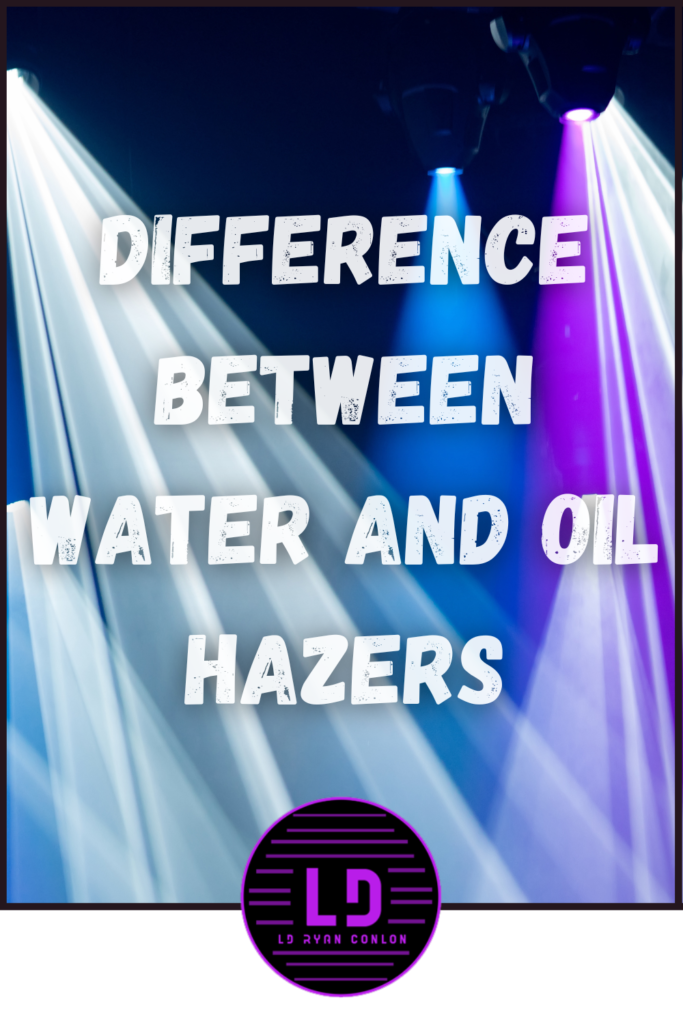

Ryan Conlon is a highly experienced Corporate Freelance Lighting Designer with two decades of dedicated work in the entertainment industry. With a passion for creating captivating lighting experiences, Ryan has contributed his expertise to numerous corporate meetings, stage productions, concerts, and events throughout his career.

